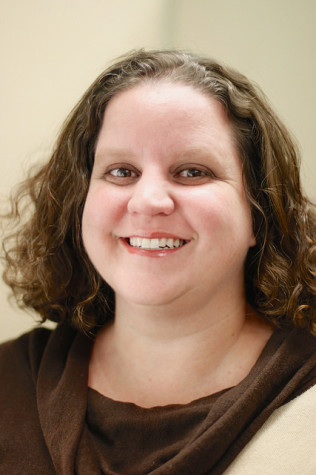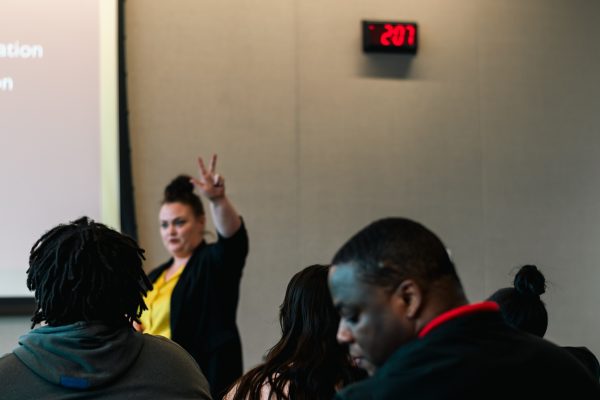EWU celebrates more than love on Valentine’s Day
February 23, 2013
- John de Graaf presents “The Happiness Initiative” on 10 ways to be happy and fulfilled.

John de Graaf presents “The Happiness Initiative” on 10 ways to be happy and fulfilled.
To kick off both the Happiness Initiative and the 26 Days of Kindness, John de Graaf, author of “What’s the Economy For, Anyway?” gave a slide presentation on Feb. 14 in the library on measuring happiness with concrete data and taking steps to improve well-being.
Over 200 people attended, according to results posted by EWU Libraries on the Happiness Initiative Facebook page.
De Graaf presented broad results from his Happiness Survey, which he has given to groups all over the world. Surveys were also made available for students to take at computers in the library after his presentation ended.
“You get what you measure,” de Graaf said. “For too long we’ve measured the wrong things. Gross domestic product doesn’t tell us whether we have a good quality of life or a sustainable society. This survey, which includes 10 domains of well-being, not just income, is a good way to start measuring the important things we care about so we can actually achieve them.”
The survey was developed by San Francisco State University’s Dr. Ryan Howell and his team. “When you take into account both time efficiency and comprehensiveness, I firmly believe this is the best well-being survey out there anywhere,” Howell said. “Individuals, organizations, academic institutions and governments can all benefit from using this survey.”
De Graaf opened his talk by describing how America’s preoccupation with personal wealth and national economic growth is detrimental to other areas of personal fulfillment.
“Where did this idea of the Happiness Initiative come from? … We’ve kind of become obsessed in this country with more and more stuff, this material lifestyle,” de Graaf said. “We just have to have more and more. The answer to everything is growth.”
The gross domestic product, defined in the dictionary as “the total value of the annual output of goods and services produced within a nation’s borders,” measures U.S. economic output quarter by quarter.
One downside of the gross domestic product, according to de Graaf, is that bad events that decrease people’s happiness and well-being can show up as positives in the gross domestic product.
According to de Graaf, because oil spills, cancer and divorce can add jobs to the economy and increase the gross domestic product, it is a poor indicator of well-being. In addition, he said, GDP does not calculate the value of what is termed “women’s work,” a sizable oversight in the attempt to measure happiness and well-being.
Instead, de Graaf suggests a measure that originated in Bhutan called the Gross National Happiness Index.
The original index had nine domains of happiness: psychological well-being, health, time use, education, cultural diversity and resilience, good governance, community vitality, ecological diversity and resilience and living standards.
To these nine domains, de Graaf has added one more: work satisfaction.
“It’s central to our economic ideas that people make informed choices, that they spend money on things that make them happy,” he said. He said that what has turned out to be true in the results of the happiness survey is that people do not always know what actually makes them happy.
These ideas are not without potential problems. De Graaf ticked them off one by one. “Some people have a problem with the term ‘happiness.’ They think that happiness is really only about pleasure, and that’s how Americans think of it. And so we have to explain that we’re talking about life satisfaction, well-being. That’s a common complaint.
“Another common complaint is that government and policy have nothing to do with happiness—it’s purely personal. Other objections are you can’t measure it. … All cultures are different. But what we’re actually finding in the science—they’re not that different, that people in a country like Bhutan, which could not be more different than the United States, understand these questions the same way that Americans do. That’s pretty telling.”
Now that the Happiness Initiative has been launched at EWU, the survey will continue to be available on the “EWU’s Happiness Initiative” Facebook page through April 22.
The Happiness Initiative will conclude with a week of happiness domain-themed activities the week of April 13 through 20. “It starts on Thomas Jefferson’s birthday and ends with Earth Day, the Saturday before April 20,” said Barbara Brock, Ph.D., library events and happiness director.
For example, the mindfulness theme will feature a meditation session led by visiting Tibetan monk the Venerable Geshe Thupten Phelgye.
The resulting data will be given to administration so they can examine areas of well-being that are good at Eastern and areas that might need more support.
A representative sampling of Americans provides baseline data so that each person who takes the survey can compare his or her individual score in each happiness domain to national average scores.
The 10 domains of happiness
- Psychological well-being: life satisfaction, emotional balance, spirituality
- Health: self-reported health status, disability, mental health
- Time use: working hours, sleeping hours, time poverty
- Education: literacy, knowledge, values, educational qualification
- Cultural diversity and resilience: language, artisan skills, sociocultural participation
- Good governance: political participation, political freedom, service delivery, government performance
- Community vitality: social support, community relationships, family, victim of crime
- Ecological diversity and resilience: pollution, wildlife, urban issues, environmental responsibility
- Living standards: income, assets, housing quality
- Work satisfaction: enjoyment of job, overwork stress, work time, personal time, control of one’s time
“It’s central to our economic ideas that people make informed choices, that they spend money on things that make them happy,” De Graaf said. He said that what has turned out to be true in the results of the happiness survey is that people do not always know what actually makes them happy.
These ideas are not without potential problems. De Graaf ticked them off one by one. “Some people have a problem with the term ‘happiness.’ They think that happiness is really only about pleasure, and that’s how Americans think of it. And so we have to explain that we’re talking about life satisfaction, well-being. That’s a common complaint.
“Another common complaint is that government and policy have nothing to do with happiness—it’s purely personal. Other objections are, ‘you can’t measure it. … All cultures are different.’ But what we’re actually finding in the science—they’re not that different, that people in a country like Bhutan, which could not be more different than the United States, understand these questions the same way that Americans do. That’s pretty telling.”
Now that the Happiness Initiative has been launched at EWU, the survey will continue to be available on the “EWU’s Happiness Initiative” Facebook page through April 22.
The Happiness Initiative will conclude with a week of happiness domain-themed activities the week of April 13 through 20. “It starts on Thomas Jefferson’s birthday and ends with Earth Day, the Saturday before April 20,” said Barbara Brock, Ph.D., library events and happiness director.
For example, the mindfulness theme will feature a meditation session led by visiting Tibetan monk the Venerable Geshe Thupten Phelgye.
The resulting data will be given to administration so they can examine areas of well-being that are good at Eastern and areas that might need more support.
A representative sampling of Americans provides baseline data so that each person who takes the survey can compare his or her individual score in each happiness domain to national average scores.






![Simmons said the biggest reasons for her success this year were “God, hard work, and trusting [her] coach and what she has planned.”](https://theeasterner.org/wp-content/uploads/2024/05/image1-1-1200x800.jpg)










